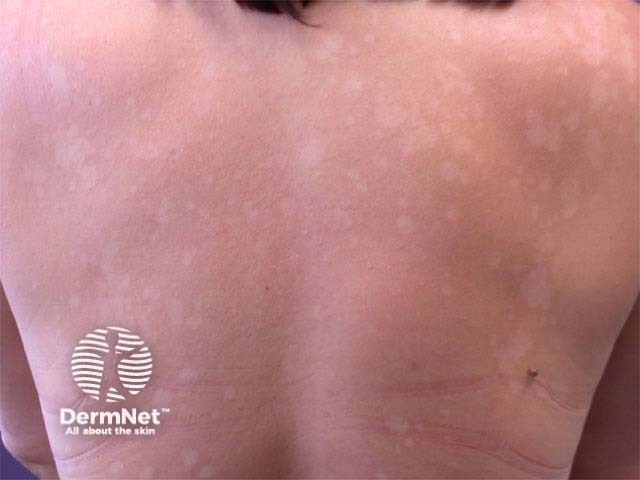Main menu
Common skin conditions

NEWS
Join DermNet PRO
Read more
Quick links
Mixed diagnoses – 10 cases (4 of 11)
For each of the ten cases, study the image(s) and then answer the questions. You can click on the image to view a larger version if required.
Each case should take approximately five minutes to complete. There is a list of suggested further reading material at the end of the quiz.
When you finish the quiz, you can download a certificate.
Case 7


What is this appearance due to?
The patient presents with numerous, slightly scaly hypopigmented patches on her trunk and proximal upper limbs, characteristic of pityriasis versicolor (sometimes incorrectly called tinea versicolor), a yeast infection. Previously classified as M. furfur, there are seven lipophilic species of Malassezia, which are normal human saprophytic yeasts but may become pathogenic in their mycelial form. Pityriasis versicolor is most often due to M. globosa. It results in mild inflammation (pink) and hyper- (brown) or hypo- (white) pigmentation with a bran-like scale.
How would you treat it?
Mild or localised pityriasis versicolor may clear with repeated applications of a topical imidazole cream, lotion or spray (especially ketoconazole cream/shampoo). However, it is more effective to use an oral imidazole (ketoconazole, fluconazole or itraconazole) for extensive infections. There are various regimes of intermittent or continuous therapy; it may be helpful to 'sweat' the medication through the skin by exercising an hour after ingestion. Relapses are common, so once monthly single-day prophylaxis is helpful. Oral imidazoles should not be used in pregnancy. Pityriasis versicolor does not respond to oral griseofulvin or terbinafine.
